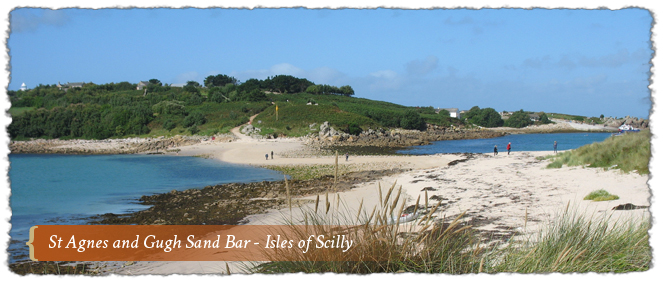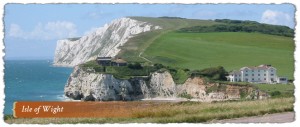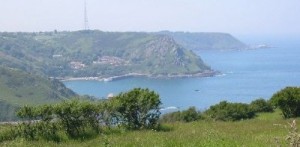
St Agnes & Hugh Sand Bar, Isles of Scilly AONB © http://www.landscapesforlife.org.uk
Isles of Scilly – Area of Outstanding Natural Beauty (AONB) is located on archipelago off the south west coast of Cornwall. The AONB designation apples to the entire archipelago including both inhabited and uninhabited islands and rocks. The AONB was established back in 1975, the area covers 16 square kilometres making it the smallest AONB in the UK. Despite the compact size the area includes a diverse range of scenery and landscapes, that one would expect from a much larger area. The area covered under the AONB designation includes granite cliffs, sandy bays, coves, lagoons, small harbours, scattered small settlements and quays.
The local population of approx 2,200 live primarily on the largest island in the archipelago St Mary's, the other inhabited island include Tresco, St Martin's, St Agnes and Bryher. in historic small towns and villages located across the countryside. The islands are known for the marine landscape and environmental quality, visitors can see sandy beaches, rugged cliffs and the unique climate means there are rare trees and flowers on the islands. The islands are of great importance for nature conservation and includes of Sites of Scientific Interest (SSSI) and Scheduled Ancient Monuments.
The area includes a number of special qualities including distinctive coastlines and exceptional seascape, important for its wildlife resources the islands' seabirds and habitats are Special Protection Area (SPA) of international importance. The areas heritage includes the greatest density of Scheduled Monuments in the UK, whilst the compact islands house 130 listed buildings.
The main industries in the AONB include the flower industry, farming and tourism, the major source of economic revenue for the island. The islands are popular for wildlife watching, wildlife and marine excursions, fishing trips, archaeological tours, diving, snorkelling ad exploring by cycle. Visitors can enjoy scenic landscapes around the islands benefiting from the great outdoors and enjoy the peace and tranquillity on the islands.
Quick Facts
Isles of Scilly Area of Outstanding Natural Beauty:
Year of Designation: 1975
Population: 2,200 (approx)
Size in square kilometres: 16
Sites of Special Scientific Interest (SSSIs): 26
Scheduled Ancient Monuments: 238
Main Settlements: Hugh Town & Old Town.
Located in: Isles of Scilly.
Attractions
The Isles of Scilly AONB are located 28 miles off the south west coast of Cornwall, England. The islands are part of the ceremonial county of Cornwall; the compact islands cover 16 square kilometres including five inhabited and numerous uninhabited islands. The entire islands are covered under the AONB designation illustrating the ecological, geographical and scientific importance of the Isles of Scilly. The islands offer something a bit different for visitors providing a scenic retreat with coastline far away from noise, traffic and pollution from the towns and cities. The islands provide somewhere most tourists to the UK do not visit offering those that do visit a scenic haven away from the crowds. The islands include a few settlements scattered across the islands, the only settlement to be regarded as a 'town' is Hugh Town on the island of St Mary's, it is the administrative, economic and commercial centre of the islands.
The Isles of Scilly include a diverse landscape including low lying and fortified headlands, the coastline includes sandy and rocky coasts, interior hills and valleys and distinct types of agricultural land. The diversity of the landscape is impressive for a relatively small area. Given the AONB covers the entire archipelago and the compact size of the islands commercial development in the protected area has been very limited providing a place for visitors to see mainly unspoilt natural scenery and coastline.
The geographic location off the south western English coast means the islands provide a place of contrasts. The North Atlantic Current ensures the islands rarely experience snow or frost allowing the cut flower industry to flourish, among the main flowers grown are daffodils. Atlantic winds mean the islands are subject to winter gales on occasions this is shown in the landscape with exposed areas displaying low heather and bare rock whilst sheltered areas have a sub tropical look to them.
The Isles of Scilly AONB are assessable by plane or boat making them assessable from across southern England including the south east and south west of England, the Midlands, east of England and southern Wales. From London, the Isles of Scilly is 4 hours 30 minutes to 5 hours by car and air, from Cardiff it is 3 to 3 hours 30 minutes, from Birmingham it is approx 4 hours 30 minutes away. From Norwich in the east of England it is 6 hours 30 minutes to 7 hours away. From these regions the AONB is assessable as a day trip, short break or longer break destination. From Liverpool, Manchester and much of northern England the area is 6 to 8 hours by car and air.
Tourist Information is located in Hugh Town, the tourist information centre is located on the island of St Mary's in Hugh Town. Here the tourist information centre provide visitors with information, help, advice and tips on the AONB area covering the various islands The knowledgeable staff provide useful local knowledge on local attractions, places of interest, things to see and do, along with local advice and tips. A visit to the tourist information centres makes for a good first port of call for visitors helping to better plan and organise trips in and around the local area.
Local Accommodation on the island includes a choice of both historic and contemporary hotels, B & B’s, Guest Houses, Self Catering houses, camping facilities and cottages. Local accommodation is available in St Mary's in High Town and on the other islands including Bryher, Tresco and St Martin's, providing good access to local facilities and transport from which to explore the islands.
Within the Isles of Scilly AONB visitors can explore a number of charming, beaches and coastline, enjoy a range of walks and trails, discover local history and archaeology and see the exotic flowers and plants. History and tradition have been well preserved offering visitors the opportunity to see the local culture.
Settlements include Hugh Town, located on the island of St Mary's, Hugh Town is located on the south west of the island. It is home to the majority of the population of the Isles of Scilly and is the one settlement on the islands regarded as a 'town'. Hugh Town is the local hub for facilities and amenities on the islands, visitors will find shops, galleries, banks, churches, cafes, pubs and restaurants. Visitors can enjoy three beaches located in close proximity, Porthcressa, Town Beach and Porthmellon that is also home to the Sailing Centre.
St Mary's is the largest of the inhabited islands on the Isles of Scilly with a population of approx 1,800, covering an area of under 2.5 square miles it includes both sea and air links making it the most likely first port of call for visitors to the islands.
Old Town is the other main settlement on the island, located under one mile east of Hugh Town, visitors will find a scenic beach, nature reserve Old Town Church famous for being the burial site of Sir Harold Wilson and a pub, shop and cafes.
Other attractions on St Mary's include the famous coastline home to a number of deserted white sandy beaches offering visitors a great place to enjoy the beach away from the crowds. There are archaeological sites, beautiful natural scenery to enjoy and a number of paths ideal for those that enjoy country and coastal walks and nature trails.
St Martin's is located to the north of St Mary's, the island is known for its idyllic beaches and crystal clear waters. The compact island is only two miles long but includes some of the finest beaches in the UK. The island is home to some stunning flowers, plants and a number of rare birds, visitors can enjoy some sensational sea views on the cliff path walks seeing the island at its finest.
The local population is approx 120; visitors can enjoy a range of local foods and drinks at a number of local eateries including lunches, snacks and cream teas. Local attractions include the flower farm an vineyard and a dive school where visitors can enjoy diving in the crystal clear waters or snorkel with the seals.
St Agnes is located a short distance south west of St Mary's and is the most southerly located island. The island is known for being unspoilt and a peaceful paradise. The small island is one mile across and it is located next to Gugh, the islands are joined by a sand bar at low tide. The island offers a number of contrasts for visitors from the tranquil, laid back setting of the sandbar between the islands of St Agnes and Gugh to the rocky outcrops on the western side and idyllic beaches located in sheltered coves.
Local industry includes working farms and flower fields alongside a number of historic cottages. Local attractions include Periglis Beach offering a fine place to enjoy a picnic, collect shells and enjoy inspiring views to Bishop Roc, the Western Rocks and Annet, the local bird sanctuary. The Old Man of Gugh is 3 metres tall and it is believed to be related to rituals dating back to the Bronze Age.
Bryher is an island located to the north west of St Mary's, known for its rugged beauty is island is known as an island of contrasts. On one side of the island is the Atlantic with its large waves whilst the other side includes sandy beaches in tranquil conditions. Home to approx 80 inhabitants, the island includes a number of attractions for visitors to see, the white sandy beaches, rocky coves and granite hills offer wonderful views. Visitors can see the granite stacks on Shipman Head whilst also enjoy the peace and tranquillity of Rushy Bay that overlooks the island of Samson.
Bryher includes the Hell Bay Hotel offering luxury accommodation, Samson Hill to the south of the island was the site for the birdman's cottage. The island includes a number of tracks and visitors will find a number of stalls that sell fresh local produce including vegetables, seafood, fudge and eggs. Boats can also be hired for boating enthusiasts.
Tresco is located north west of St Mary's next to the island of Bryher. It is the second largest of the islands after St Mary's and has been referred to as a sub-tropical gem. The island is privately owned, it offers a choice of attractions for visitors to discover. Local attractions include bronze age burial sites, historic castle ruins and sandy beaches away from the crowds. The famous Tresco Abbey Garden is located here.
Tresco Abbey Gardens are sub tropical gardens dating back to the 1830's. The gardens are a haven for horticulture enthusiasts and include in excess of 20,000 exotic plants from all over the world including a number that cannot be grown anywhere else in the UK. Along with the gardens is the remains of Benedictine Abbey that was founded back in 964 AD, the gardens are also home to a collection of shipwrecked figureheads, these are displayed at the Valhalla Museum. The sheer range and extraordinary diversity of flower and plant life makes the gardens unique, visitors can walk on a number of paths in the gardens to experience the full range of flowers and plants on show.
The north of Tresco with its rugged landscape provides a great place to walk, in the centre of the island birds seek out local freshwater pools. Visitors can use bicycles to tour the island and enjoy kayaking and windsurfing at the Tresco Sailing Club. The wonderful beaches offer a great place to sit back, relax and enjoy the beautiful natural scenery and coastline.
Walking is a popular activity in the AONB, providing a great way to explore the islands, there are in excess of 30 miles of nature trails and walks in the island of St Mary's and more on the other islands. Walkers will find wonderful country and coastal scenery to enjoy along with seeing the local wildlife and historic monuments up close. There are a number of self guided routes for exploring each of the islands and there are a choice of guided walks that include resident naturalists and ornithologists whose expert local knowledge provide great insight in to local history, culture and wildlife. Walking enthusiasts can take part in the Walk Scilly week long walking festival that takes place annually in April.
Cycling provides a cost effective and environmentally friendly way to explore the islands seeing a range of attractions and places of interest up close. The compact size of the island means it is suitable for cyclists of all abilities.
Visitors to the Isles of Scilly AONB will find a quiet scenic haven with scenic beauty and an impressive coastline. There is a varied landscape and special qualities in the AONB belies the compact size of the islands making a visit to the islands an attractive option for those looking for a bit of adventure and something a bit different.
How to Get There
Isles of Scilly AONB is accessible by both air and ferry.
By Car:
The Isles of Scilly is located approx 300 miles from London. From London, take the a4 then the M4 up to junction 20. Then take the M5 exit to Bristol (west), at junction 29 take the A30 and then the B3184 that goes to Exeter Airport. From Exeter Airport Skybus provide regular flights to the Isles of Scilly. The total journey time is approx 4 hours 30 minutes to 5 hours by car and air depending on traffic connections and time of day. Alternatively from Newquay and Land's End Airport there are flights to the Isles of Scilly, the journey time for the flights are approx 30 minutes and 15 minutes. There are ferry services available as an alternative to air travel to and from the islands. From Penzance there are ferries available to the islands, the journey time is 2 hours 45 minutes. Ferry Services from Penzance are provided by: Isles of Scilly Travel.
By Train:
The train station at Exeter St David's has regular services from London Paddington and London Waterloo stations. The approx journey time is 2 hours 30 minutes to 3 hours 40 minutes. From Exeter there are flights available to the islands. From London Paddington there are train services available to Penzance train station with an approx journey time of 5 hours to 5 hours 30 minutes depending on time of day and connections. From Penzance there are ferry services available to the islands.
By Bus/Coach:
There are regular buses available from London Victoria Coach station to both Penzance and Exeter. The approx journey time is 8 hours 20 minutes to 9 hours for Penzance and 4 to 5 hours for Exeter depending on time of day, connections and traffic. Coach services to Penzance and Exeter are provided by services are provided by National Express.
Contact Details
Isles of Scilly AONB Officer
Old Wesleyan Chapel
Garrison Lane
St Mary's
Isles of Scilly
TR21 0JD
Telephone: +44 (0)1720 423 486
Website: Isles of Scilly AONB
Map
For Local Search and Directions see: Isles of Scilly (AONB) Map
Tips & Other Considerations
The weather and climate can be unpredictable, there can be elements of all four seasons in one day. Ensure you check the weather forecast before you travel and have the correct clothing and footwear including comfortable walking shoes, fleece, raincoat and umbrella.
Follow travel advice and remain alert, vigilant and aware of your belongings at all times especially your wallet/purse and valuables and ensure they are hidden away from public view. If you have a bag try to use a shoulder bag with a good quality, strong strap, that is put across your shoulder not on your shoulder making it more difficult for anyone to take your bag.
Use the journey planner for door to door directions. Check traffic updates before you travel.
If you are looking for car parking in and around the AONB, ensure you fully understand the rules, regulations & charges for car parks and street parking. The rules & regulations can be complex & confusing if you are unclear, it is wise not to park there.
If you are travelling by public transport, check for service updates prior to beginning your journey for any delays, disruption or cancellations to services that may impact on your journey. Ensure you have the service timetables for the trains, trams, buses and coaches. Remember when the last services are and ensure you make it to the train/bus/coach stops well in time to avoid missing the service.
Disclaimer: The information given in on this website is given in good faith and to the best of our knowledge. If there are any discrepancies in no way do we intend to mislead. Important travel details and arrangements should be confirmed and verified with the relevant authorities.




